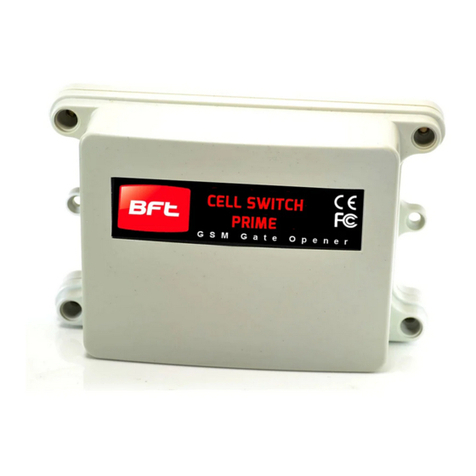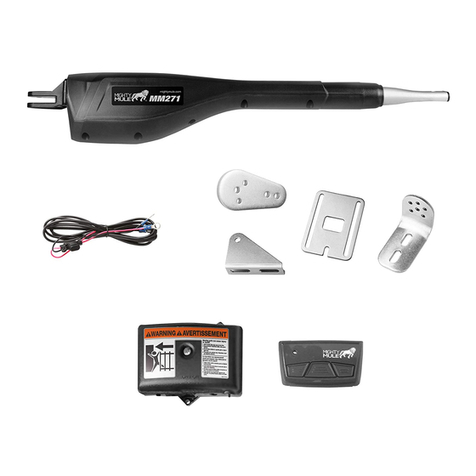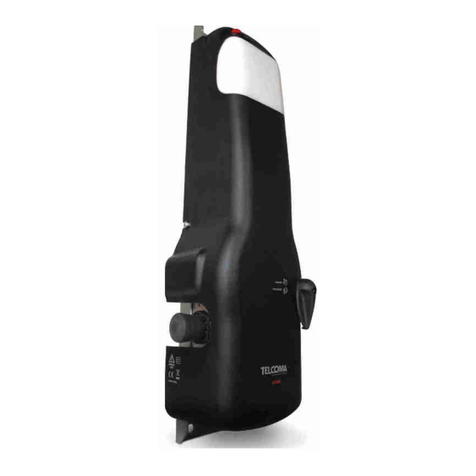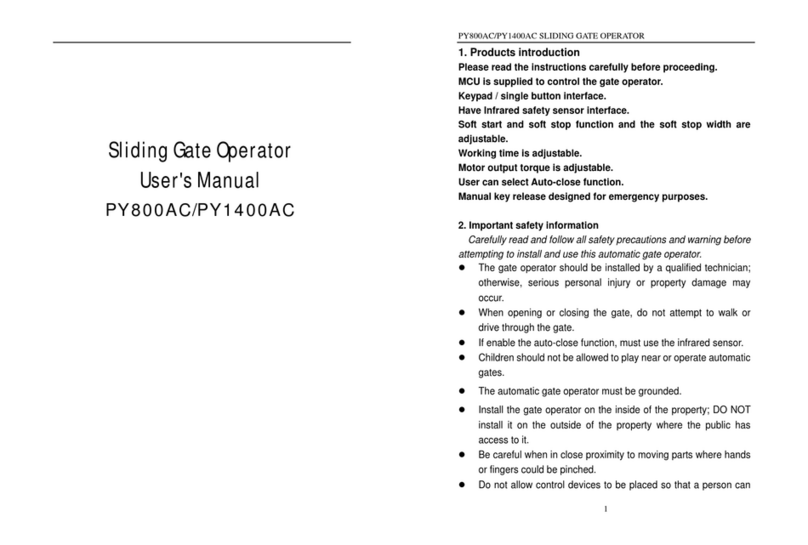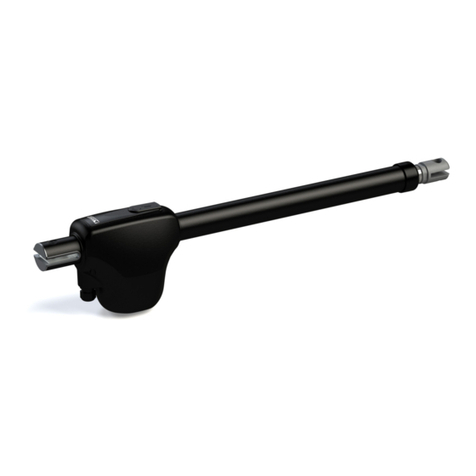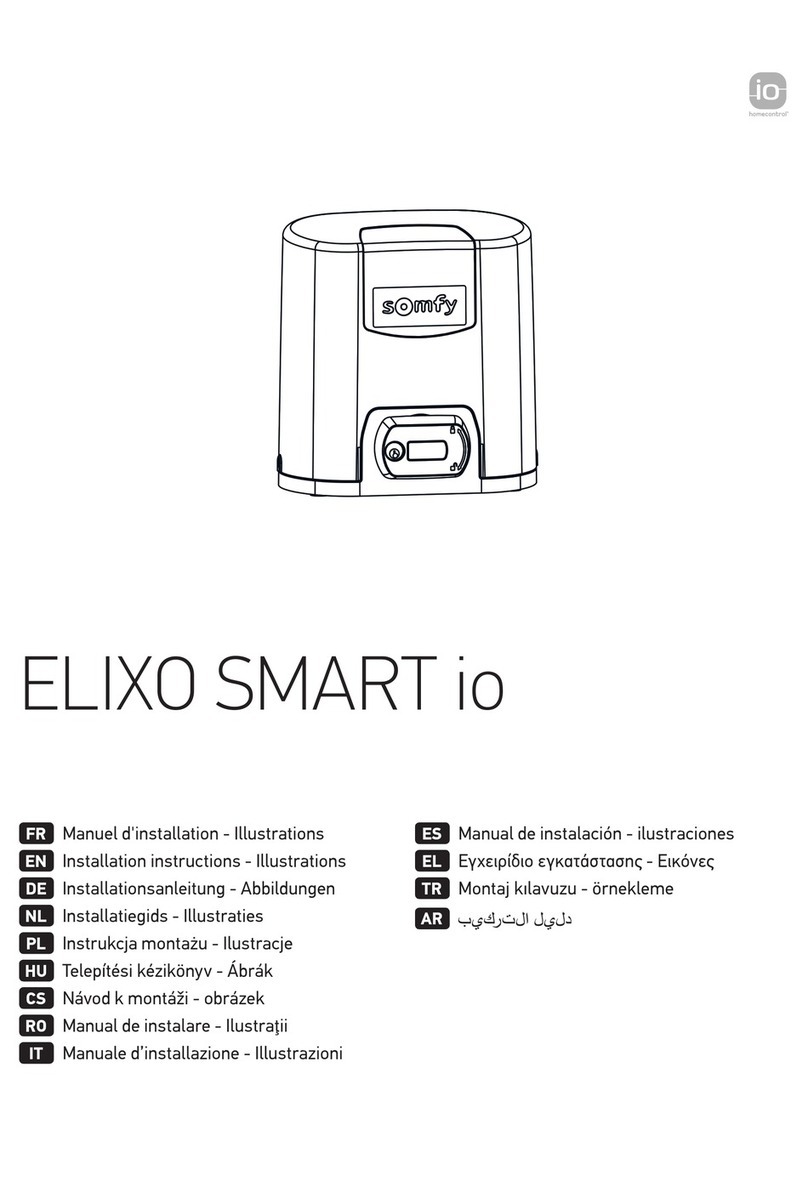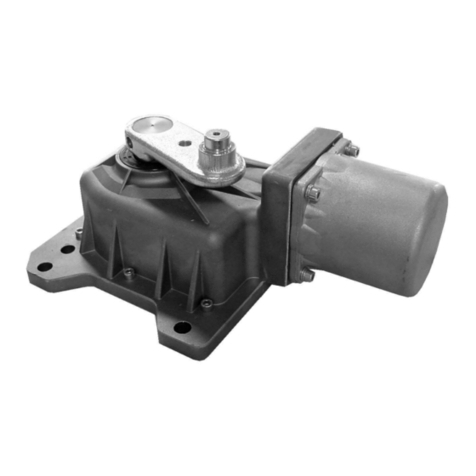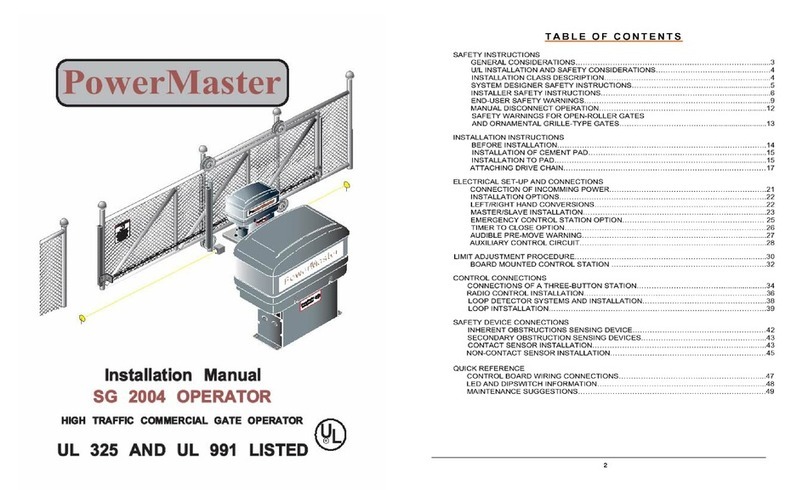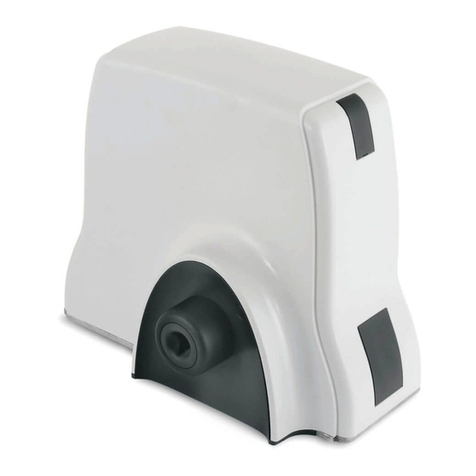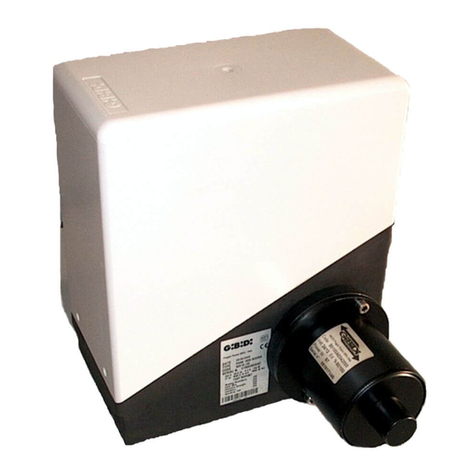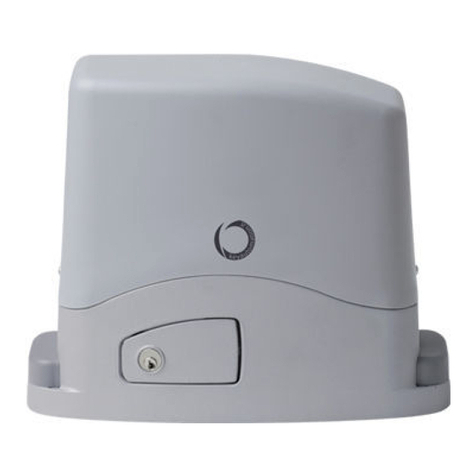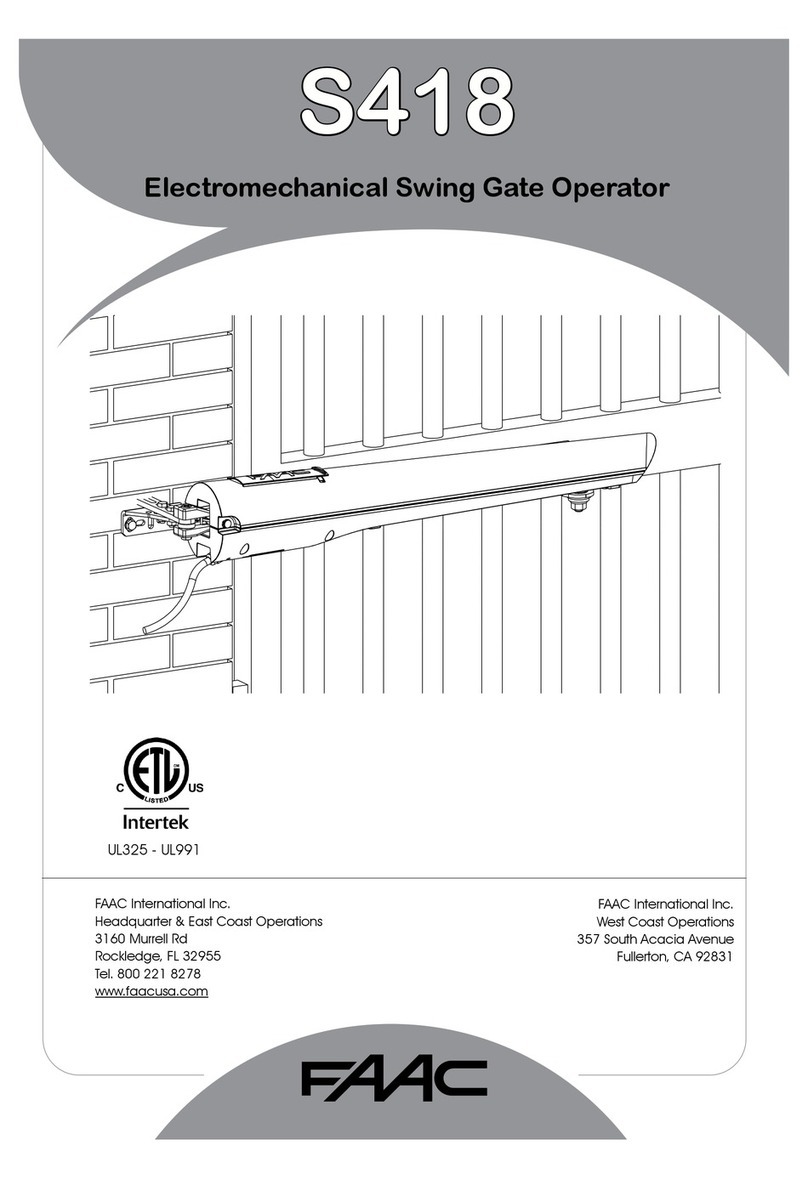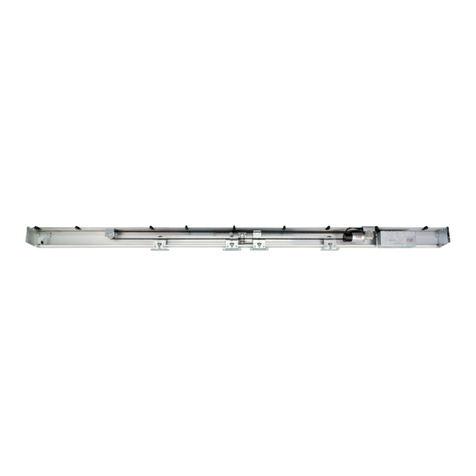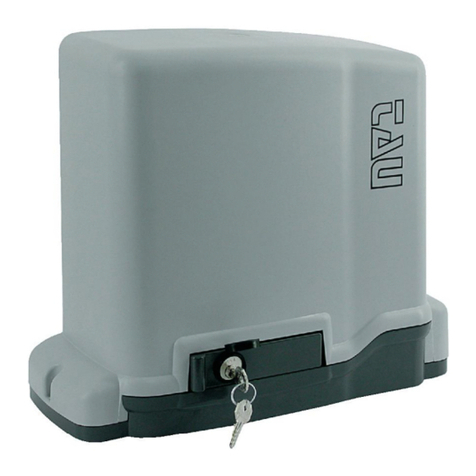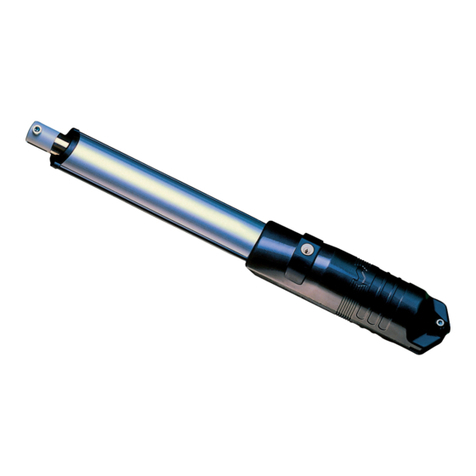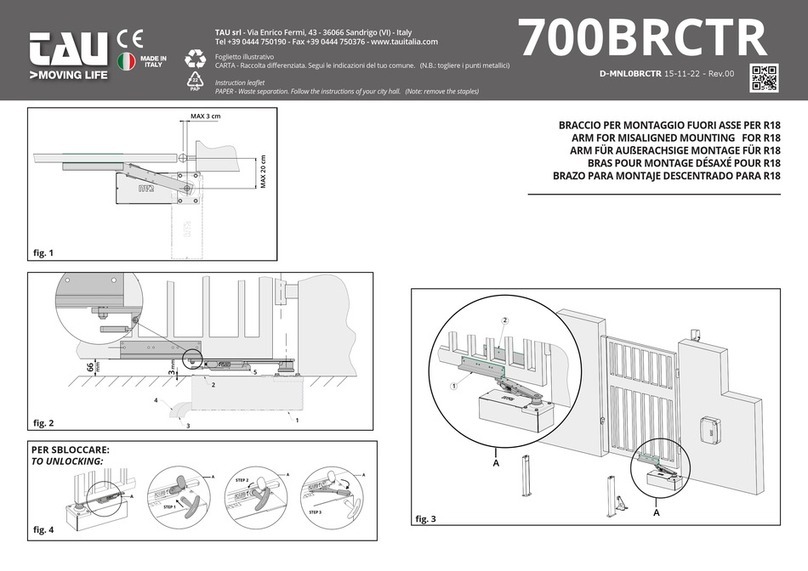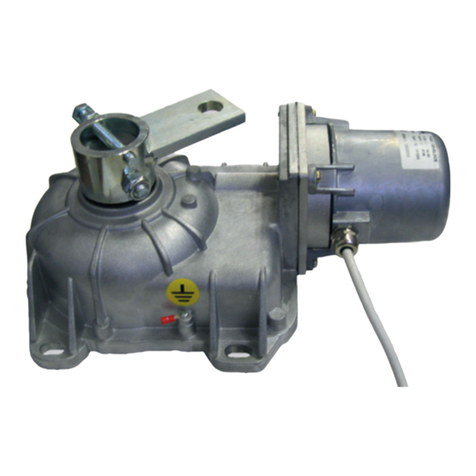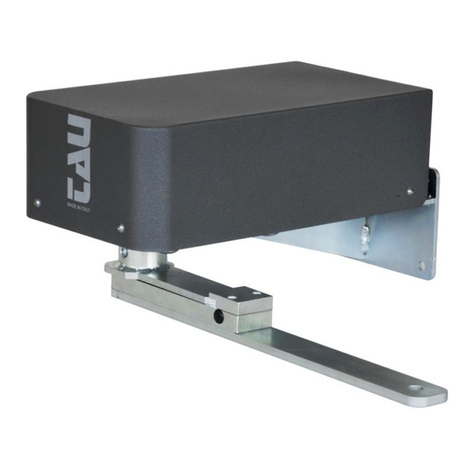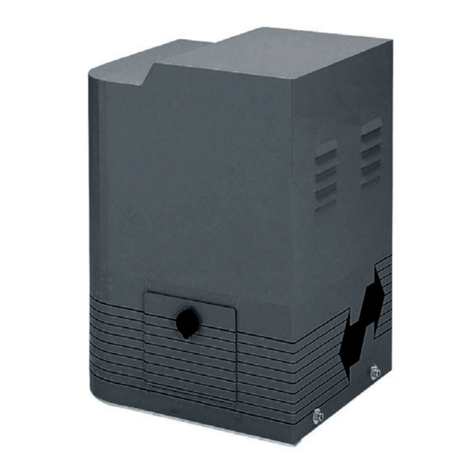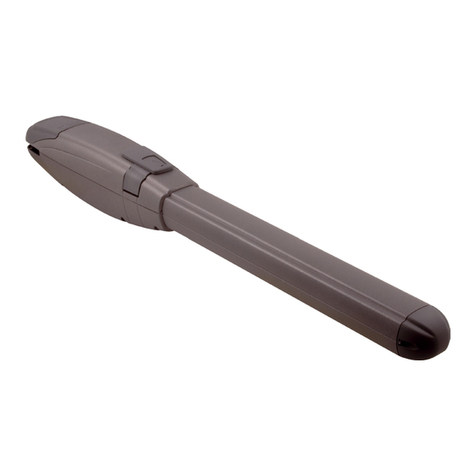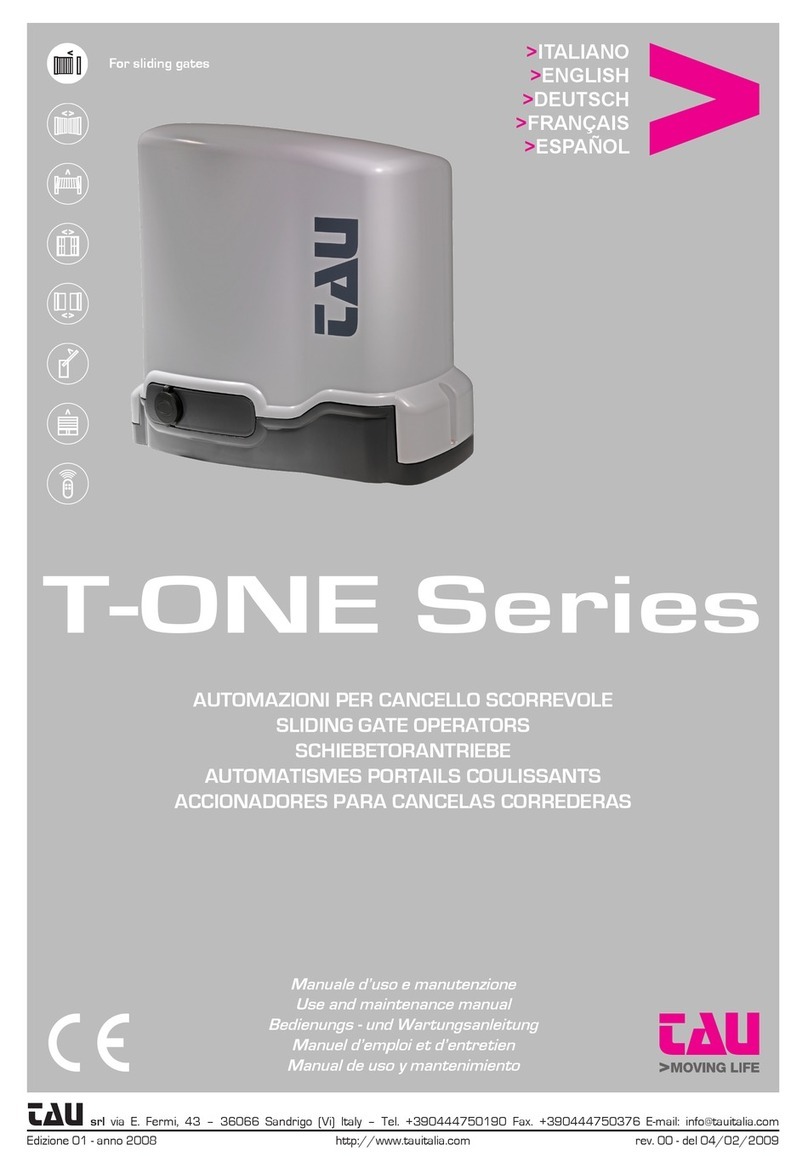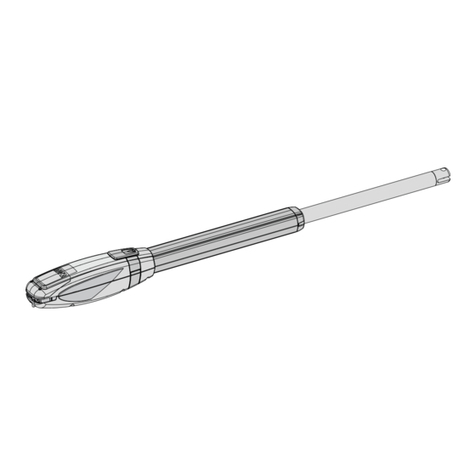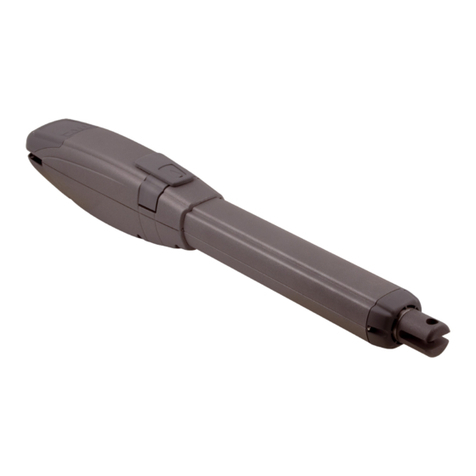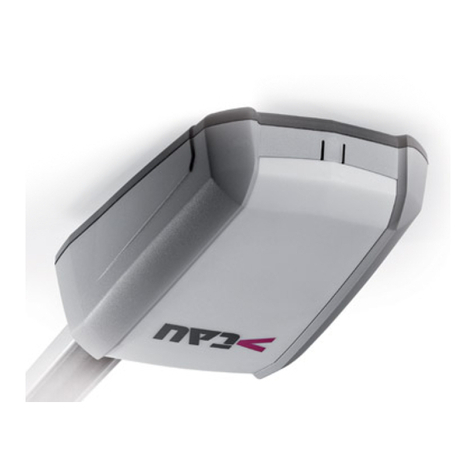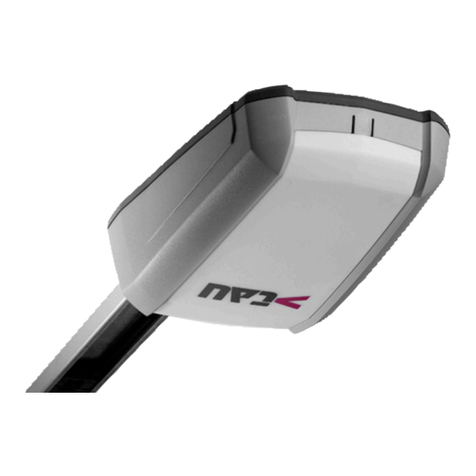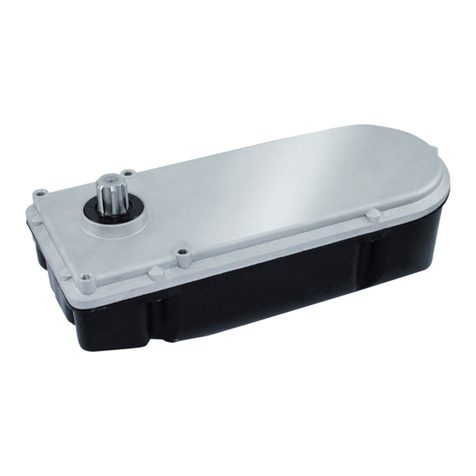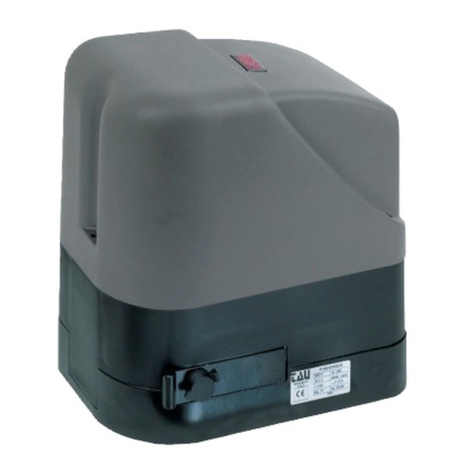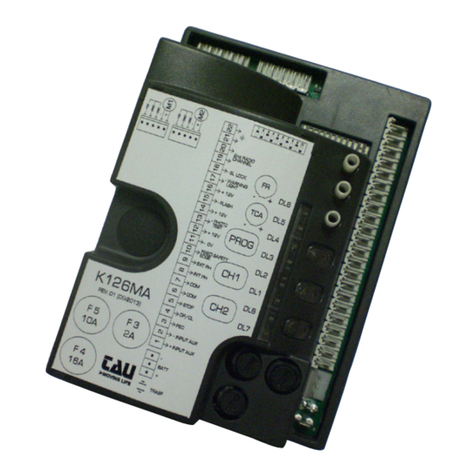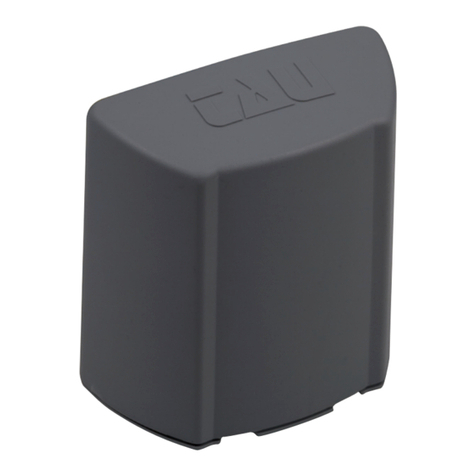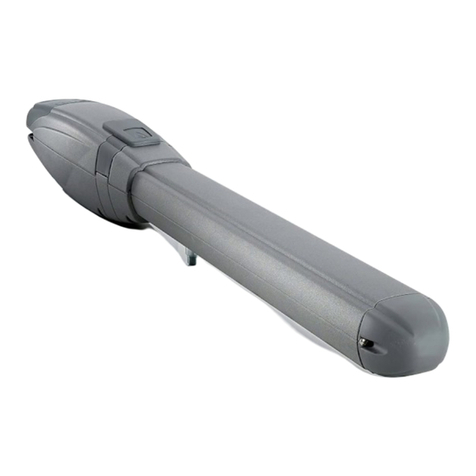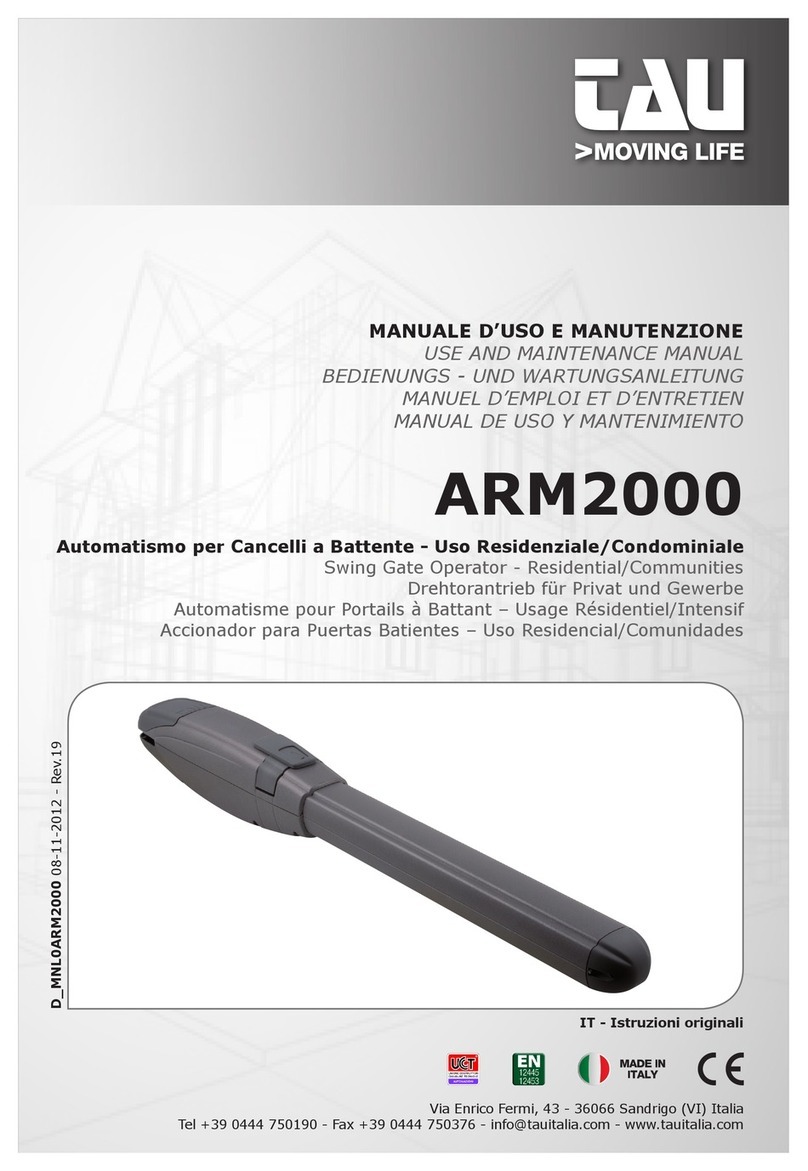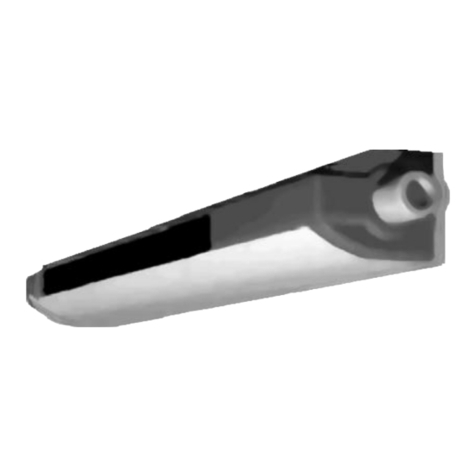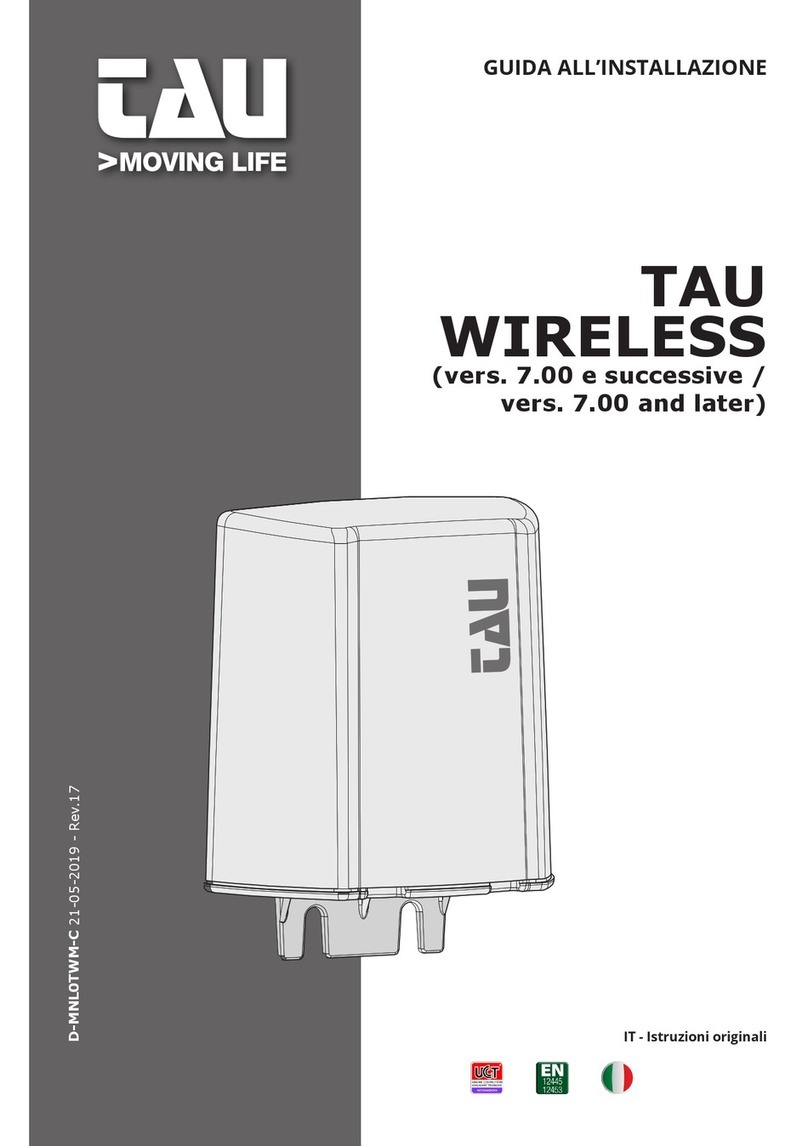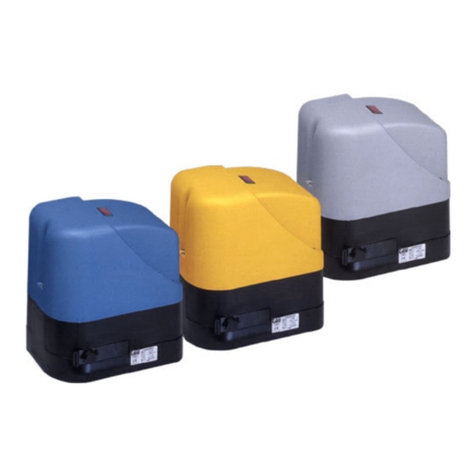
8
HINWEISE FÜR DEN INSTALLATEUR
ALLGEMEINE PFLICHTEN BEZÜGLICH DER SICHER-
HEIT
1) Lesen Sie vor der Installation genau die Anweisungen, da
sie wichtige Hinweise bezüglich der Sicherheit, der Instal-
lation, der Bedienung sowie der Wartung enthalten. Eine
falsche Installation oder eine falsche Anwendung des Pro-
dukts kann zu schweren Verletzungen führen.
2) Das Verpackungsmaterial (Kunststo, Polystyrol usw.) darf
nicht in der Reichweite von Kindern aufbewahrt werden, da es
eine mögliche Gefahrenquelle darstellt.
3) Die Anleitungen für einen späteren Bedarf aufbewahren.
4) Dieses Produkt wurde ausschließlich für den in diesen Unter-
lagen angegebenen Zweck entwickelt und gebaut. Jede ande-
re nicht ausdrücklich angegebene Nutzung könnte die Unver-
sehrtheit des Produkts beeinträchtigen und/oder eine Gefah-
renquelle darstellen.
5) TAU lehnt jede Verantwortung für einen unsachgemäßen oder
nicht den Angaben entsprechenden Gebrauch der Automatisie-
rung ab.
6) Das Produkt nicht in EX-gefährdeter Atmosphäre oder Umge-
bung installieren.
7) Die mechanischen Bauteile müssen mit den Vorschriften der
Norm EN 12604 und EN 12605 übereinstimmen. In außereuro-
päischen Ländern müssen außer den nationalen Vorschriften
auch die oben genannten Normen befolgt werden, um eine
ausreichende Sicherheitsstufe zu erreichen.
8) TAU übernimmt keinerlei Haftung im Falle von nicht fachge-
rechter Konstruktion der Toröner oder im Falle von Verfor-
mungen derselben während des Gebrauchs.
9) Die Installation muss bei Einhaltung der Normen EN 12453 und
EN 12445 vorgenommen werden. In außereuropäischen Län-
dern müssen außer den nationalen Vorschriften auch die oben
genannten Normen befolgt werden, um eine ausreichende Si-
cherheitsstufe zu erreichen.
10) Vor der Ausführung beliebiger Arbeiten an der Anlage die
Stromspeisung entfernen und die Batterien abtrennen.
11)
Im Speisungsnetz der Automatisierung einen allpoligen Schalter
mit einer Önungsdistanz der Kontakte gleich oder über 3 mm
vorsehen. Wir empfehlen, einen 6A-Magnetthermoschalter mit ei-
ner allpoligen Unterbrechung zu verwenden.
AVERTISSEMENTS POUR L’INSTALLATEUR
CONSIGNES GÉNÉRALES DE SÉCURITÉ
1) Lire attentivement les instructions avant de procéder à
l’installation, dans la mesure où elles fournissent des indi-
cations importantes concernant la sécurité, l’installation,
l’utilisation et la maintenance. Une installation incorrecte
ou une utilisation impropre du produit peut entraîner de
graves dommages aux personnes.
2) Les matériaux de l’emballage (plastique, polystyrène expansé,
etc.) ne doivent pas être laissés à la portée des enfants dans la
mesure où ils sont une source potentielle de danger.
3) Conserver les instructions pour toute consultation future.
4) Ce produit a été conçu et construit exclusivement pour l’utilisa-
tion indiquée dans cette documentation. Toute autre utilisation
qui n’est pas expressément indiquée peut compromettre l’inté-
grité du produit et/ou représenter une source de danger.
5) TAU décline toute responsabilité dérivant de l’utilisation im-
propre ou diérente de celle à laquelle l’automatisme est des-
tiné.
6) Ne pas installer le produit dans une atmosphère et un environ-
nement explosifs.
7) Les éléments mécaniques doivent être conformes aux normes
EN 12604 et EN 12605. Pour les pays extra-CEE, en plus des
normes relatives à chaque pays, pour obtenir un niveau de
sécurité adéquat, il faut respecter également les normes sus-
mentionnées.
8) TAU n’est pas responsable de la non-observation des règles de
l’art dans la construction des fermetures à motoriser, ainsi que
des déformations qui pourraient se vérier lors de l’utilisation.
9) L’installation doit être eectuée dans le respect des normes
EN 12453 et EN 12445. Pour les pays extra-CEE, en plus des
normes relatives à chaque pays, pour obtenir un niveau de
sécurité adéquat, il faut respecter également les normes sus-
mentionnées.
10) Avant d’eectuer n’importe quelle intervention sur l’installation,
couper l’alimentation électrique et déconnecter les batteries.
11)
Prévoir sur le réseau d’alimentation de l’automatisation un inter-
rupteur omnipolaire avec distance d’ouverture des contacts égal
ou supérieur à 3 mm. Il est conseillé d’utiliser un interrupteur ma-
gnétothermique de 6A avec interruption omnipolaire.
12) Vérier qu’en amont de l’installation il y a un interrupteur dié-
rentiel avec seuil de 0,03 A.
13) Vérier que l’installation de mise à la terre est réalisée dans les
règles de l’art et y raccorder les parties métalliques de la ferme-
12) Prüfen, ob hinter der Anlage ein Dierenzialschalter mit max.
0,03 A vorliegt.
13) Prüfen, ob die Erdung fachgerecht ausgeführt wurde und die
Metallteile des Toröners daran anschließen.
14) Die Sicherheitsvorrichtungen (Norm EN 12978) ermöglichen
den Schutz eventueller Gefahrenbereiche vor mechanischen
Bewegungsrisiken, wie z.B. Einquetschen, Mitziehen, Schnei-
den.
15) Für jede Anlage sind die Verwendung mindestens einer Leucht-
anzeige und eines Hinweisschilds, das am Rahmen befestigt
wird, sowie die Vorrichtungen laut Punkt 14 empfehlenswert.
16) TAU lehnt jede Haftung hinsichtlich der Sicherheit und der
Funktionstüchtigkeit der Automatisierung ab, falls nicht von
TAU hergestellte Anlagenteile verwendet werden.
17) Zur Instandhaltung ausschließlich TAU-Originalersatzteile ver-
wenden.
18) Keine Änderung an Bestandteilen des Automatisierungssys-
tems ausführen.
19) Der Installateur muss alle Informationen bezüglich des manu-
ellen Betriebs des Systems im Notfall weitergeben und dem An-
wender der Anlage die dem Produkt beigelegte „Bedienungsan-
leitung“ aushändigen.
20) Kindern oder anderen Personen nicht erlauben, während des
Betriebs in der Nähe des Produkts zu bleiben.
21) Fernsteuerungen oder andere Impulsgeber außerhalb der
Reichweite von Kindern aufbewahren, um zu vermeiden, dass
die Automatisierung ungewollt betätigt wird.
22) Der Durchgang darf nur bei stehender Automatisierung erfol-
gen.
23) Der Durchgang oder die Durchfahrt zwischen den Flügeln darf
lediglich bei vollständig geönetem Tor erfolgen.
24) Wartung: Mindestes alle sechs Monate die Funktionstüchtigkeit
der Anlage prüfen, mit besonderer Beachtung der Ezienz der
Sicherheitsvorrichtungen (einschließlich der Schubkraft der Au-
tomatisierung, wo vorhanden) und der Entriegelungsvorrich-
tungen.
25) Alles nicht ausdrücklich in diesen Anweisungen vorgesehene ist
unzulässig.
Wir empfehlen, die ganzen Unterlagen bezüglich der Anlage inner-
halb oder in der Nähe des Steuergeräts aufzubewahren.
ture.
14) Les dispositifs de sécurité (norme EN 12978) permettent de
protéger les éventuelles zones de danger contre les Risques
mécaniques de mouvement, comme par exemple l’écrase-
ment, l’entraînement, le cisaillement.
15) Pour chaque installation il est conseillé d’utiliser au moins une
signalisation lumineuse ainsi qu’un panneau de signalisation
xé de manière adéquate sur le bâti de la porte ou du portail,
en plus des dispositifs cités au point 14.
16)
TAU décline toute responsabilité aux ns de la sécurité et du bon
fonctionnement de l’automatisation en cas d’utilisation de compo-
sants de l’installation qui ne sont pas produits par TAU.
17) Pour la maintenance, utiliser exclusivement des pièces d’ori-
gine TAU.
18) N’eectuer aucune modication sur les composants faisant
partie du système d’automatisation.
19) L’installateur doit fournir toutes les informations relatives au
fonctionnement manuel du système en cas d’urgence et re-
mettre à l’utilisateur de l’installation le « Guide de l’utilisateur »
joint au produit.
20) Ne pas permettre aux enfants ou aux personnes de stationner
à proximité du produit durant le fonctionnement.
21) Conserver hors de portée des enfants les radiocommandes ou
tout autre dispositif émettant des impulsions, pour éviter que
l’automation puisse être actionnée involontairement.
22) Le transit entre les vantaux ne doit avoir lieu que lorsque le
portail est complètement ouvert.
23) L’utilisateur doit s’abstenir de toute tentative de réparation ou
d’intervention directe et s’adresser uniquement à du personnel
qualié.
24) Maintenance : eectuer au moins une fois par semestre le
contrôle de fonctionnement de l’installation, avec une attention
particulière pour les dispositifs de sécurité (incluant, quand
c’est prévu, la force de poussée de l’opérateur) et de débrayage.
25) Tout ce qui n’est pas expressément prévu dans ces instructions
n’est pas autorisé.
Nous conseillons de conserver toute la documentation relative
à l’installation à l’intérieur ou à proximité de la logique de com-
mande.
DEUTSCHFRANÇAIS





















